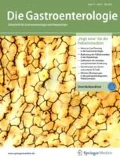Zusammenfassung
Sklerosierende Cholangitiden sind als entzündlich-fibrosierende Erkrankungen der Gallenwege mit einem typischen „perlschnurartigen“ Bild im Cholangiogramm definiert. Die Ursachen können dabei mannigfaltig sein, so dass letztendlich eine Reihe unterschiedlicher Ätiologien in einem morphologisch ähnlichen Phänotyp münden. Die korrekte Diagnose ist jedoch in Hinblick auf Komplikationen und Therapie essenziell. Bei der primär sklerosierenden Cholangitis herrscht ein hohes Kolon- und Cholangiokarzinomrisiko vor, was für die anderen Entitäten nicht gezeigt ist. Ebenso ist die Assoziation mit chronisch-entzündlichen Darmerkrankungen verschieden. Therapeutisch profitieren Patienten mit IgG4-assoziierter Cholangitis von einer Steroidbehandlung, während Steroide bei primär und sekundär sklerosierender Cholangitis ineffektiv sind.
Abstract
Sclerosing cholangitis is a chronic cholestatic biliary disease leading to biliary strictures. Primary sclerosing cholangitis (PSC), IgG4-associated cholangitis (IAC) and secondary sclerosing cholangitis (SCC) continue to pose differential diagnostic difficulties. However, the correct diagnosis is crucial regarding differences in complications and therapeutic strategy. In contrast to IAC and SSC, PSC carries a high risk of cholangiocellular and colon cancer. Moreover, only PSC is associated with inflammatory bowel disease. Patients with IAC benefit from steroid therapy, whereas steroids are not effective in patients with SSC and PSC.




Literatur
Bergquist A, Ekbom A, Olsson R et al (2002) Hepatic and extrahepatic malignancies in primary sclerosing cholangitis. J Hepatol 36: 321–327
Björnsson E, Chari S, Silveira M et al (2011) Primary sclerosing cholangitis associated with elevated immunoglobulin G4: clinical characteristics and response to therapy. Am J Ther 18: 198–205
Björnsson E, Olsson R, Bergquist A et al (2008) The natural history of small-duct primary sclerosing cholangitis. Gastroenterology 134: 975–980
Boberg KM, Chapman RW, Hirschfield GM et al (2011) Overlap syndromes: the International Autoimmune Hepatitis Group (IAIHG) position statement on a controversial issue. J Hepatol 54: 374–385
Broomé U, Olsson R, Lööf L et al (1996) Natural history and prognostic factors in 305 Swedish patients with primary sclerosing cholangitis. Gut 38: 610–615
Gelbmann CM, Rümmele P, Wimmer M et al (2007) Ischemic-like cholangiopathy with secondary sclerosing cholangitis in critically ill patients. Am J Gastroenterol 102: 1221–1229
Gelbmann CM, Schölmerich J (2007) Sekundär sklerosierende Cholangitis bei Intensivpatienten. Gastroenterologe 3: 45–50
Ghazale A, Chari ST, Zhang L et al (2008) Immunoglobulin G4-associated cholangitis: clinical profile and response to therapy. Gastroenterology 134: 706–715
Gotthardt DN, Rudolph G, Klöters-Plachky P et al (2010) Endoscopic dilation of dominant stenoses in primary sclerosing cholangitis: outcome after long-term treatment. Gastrointest Endosc 71: 527–534
Hov JR, Keitel V, Laerdahl JK et al (2010) Mutational characterization of the bile acid receptor TGR5 in primary sclerosing cholangitis. PloS One 5: e12403
Karlsen TH, Franke A, Melum E et al (2010) Genome-wide association analysis in primary sclerosing cholangitis. Gastroenterology 138: 1102–1111
Karlsen TH, Schrumpf E, Boberg KM (2010) Update on primary sclerosing cholangitis. Dig Liver Dis 42: 390–400
Kawakami H, Zen Y, Kuwatani M et al (2010) IgG4-related sclerosing cholangitis and autoimmune pancreatitis: histological assessment of biopsies from Vater’s ampulla and the bile duct. J Gastroenterol Hepatol 25: 1648–1655
Kulaksiz H, Heuberger D, Engler S, Stiehl A (2008) Poor outcome in progressive sclerosing cholangitis after septic shock. Endoscopy 40: 214–218
Lankisch TO, Metzger J, Negm AA et al (2011) Bile proteomic profiles differentiate cholangiocarcinoma from primary sclerosing cholangitis and choledocholithiasis. Hepatology (Baltimore, Md.) 53: 875–884
Lindkvist B, Benito de Valle M, Gullberg B, Björnsson E (2010) Incidence and prevalence of primary sclerosing cholangitis in a defined adult population in Sweden. Hepatology 52: 571–577
Melum E, Franke A, Schramm C et al (2011) Genome-wide association analysis in primary sclerosing cholangitis identifies two non-HLA susceptibility loci. Nat Genet 43: 17–19
Metzger J, Negm AA, Plentz RR et al (2012) Urine proteomic analysis differentiates cholangiocarcinoma from primary sclerosing cholangitis and other benign biliary disorders. Gut (Epub ahead of print)
Negm AA, Schott A, Vonberg R-P et al (2010) Routine bile collection for microbiological analysis during cholangiography and its impact on the management of cholangitis. Gastrointest Endosc 72: 284–291
Ruemmele P, Hofstaedter F, Gelbmann CM (2009) Secondary sclerosing cholangitis. Nat Rev Gastroenterol Hepatol 6: 287–295
Takuma K, Kamisawa T, Igarashi Y (2011) Autoimmune pancreatitis and IgG4-related sclerosing cholangitis. Curr Opin Rheumatol 23: 80–87
Tischendorf JJW, Hecker H, Krüger M et al (2007) Characterization, outcome, and prognosis in 273 patients with primary sclerosing cholangitis: a single center study. Am J Gastroenterol 102: 107–114
Voigtländer T, Negm A, Schneider A et al (2012) Secondary sclerosing cholangitis in critically Ill patients: MELD score and renal function predict outcome. Endoscopy (in press)
Vosskuhl K, Negm AA, Framke T et al (2012) Measurement of IgG4 in bile: a new approach for the diagnosis of IgG4-associated cholangiopathy. Endoscopy 44: 48–52
Weismüller TJ, Lankisch TO (2011) Medical and endoscopic therapy of primary sclerosing cholangitis. Best practice and research. Clin Gastroenterol 25: 741–752
Weismüller TJ, Wedemeyer J, Kubicka S et al (2008) The challenges in primary sclerosing cholangitis–aetiopathogenesis, autoimmunity, management and malignancy. Journal of hepatology 48(Suppl 1): S38–57
Beuers U (2009) EASL Clinical Practice Guidelines: management of cholestatic liver diseases. J Hepatol 51: 237–267
Interessenkonflikt
Der korrespondierende Autor gibt für sich und seine Koautoren an, dass kein Interessenkonflikt besteht.
Author information
Authors and Affiliations
Corresponding author
Rights and permissions
About this article
Cite this article
Weismüller, T., Strassburg, C., Manns, M. et al. Sklerosierende Cholangitiden. Gastroenterologe 7, 483–492 (2012). https://doi.org/10.1007/s11377-011-0623-0
Published:
Issue Date:
DOI: https://doi.org/10.1007/s11377-011-0623-0
Schlüsselwörter
- Primär sklerosierende Cholangitis (PSC)
- IgG4-assoziierte Cholangitis (IAC)
- Sekundär sklerosierende Cholangitis (SSC)
- Cholangiozelluläres Karzinom (CCC)
- Steroide

